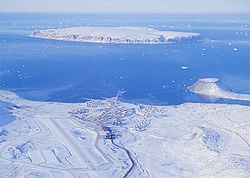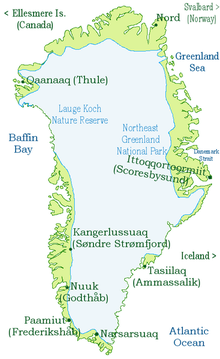Pituffik Space Base
Part of Air Force Space Command (AFSPC) | |||||||||||
|---|---|---|---|---|---|---|---|---|---|---|---|
 | |||||||||||
| Summary | |||||||||||
| Airport type | Military | ||||||||||
| Operator | United States Air Force | ||||||||||
| Location | Qaanaaq | ||||||||||
| Elevation AMSL | 77 m / 251 ft | ||||||||||
| Coordinates | 76°31′53″N 68°42′12″W / 76.53139°N 68.70333°W | ||||||||||
 | |||||||||||
| Runways | |||||||||||
| |||||||||||



Thule Air Base, (or Thule Air Base/Pituffik Airport) (IATA: THU, ICAO: BGTL), an unincorporated enclave within Qaanaaq municipality, Greenland, is the United States Air Force's northernmost base, located 1118 km (695 mi) north of the Arctic Circle and 1524 km (947 mi) south of the North Pole on the northwest side of the island of Greenland. It is approximately 885 km (550 mi) east of the North Magnetic Pole. It is the site of the former town of Dundas, which was moved to Qaanaaq for the construction of the base. The permanent population of the base was 235 as of January 1, 2005. Location: 76°32′N 68°50′W / 76.533°N 68.833°W.
History
The military installations at Thule were constructed just after World War II, after the U.S. in 1941 established ties with a Greenland left essentially autonomous by the Nazi German occupation of Greenland's colonial power Denmark. By 1951 sufficient improvements to the infrastructure had been made to station some bombers here during the Cold War with the Soviet Union.
1950s
With only a few days notice, the local Inuit community was forced to move away from their ancient hunting grounds in May 1953 and resettle in Qaanaaq, north of Thule. They were not awarded compensation until 1999.
Originally established as a Strategic Air Command (SAC) installation, Thule would periodically serve as a dispersal base for B-36 Peacemaker and B-47 Stratojet aircraft during the 1950s, as well as providing an ideal site to test the operability and maintainability of these weapon systems in extreme cold weather. Similar operations were also conducted with B-52 Stratofortress aircraft in the 1950s and 1960s.
In 1954, Globecom Tower, a tower for military radio communication was built. At the time of its completion it was the third tallest man-made structure on earth.
In the winter of 1956-57 three KC-97 tankers and alternately one of two RB-47H aircraft made polar flights to inspect Soviet defenses. Five KC-97s prepared for flight with engines running in at temperatures of −50 °F (−46 °C) in order to ensure three got airborne. After a two hour start, a B-47 would catch up with them at the northeast coastline of Greenland where two would offload fuel to top off the B-47's tanks (the third was an air spare). The B-47 would then fly seven hours of reconnaissance, while the tankers would return to Thule, refuel, and three would again fly to rendezvous with the returning B-47 at NE Greenland. The B-47 averaged ten hours and 4500 km (2800 mi) in the air, unless unpredictable weather closed Thule. In that case the three tankers and the B-47 had to additionally fly to one of three equidistant alternates: England, Alaska, or Labrador. All of this in sometimes moonless, 24 hour Arctic darkness December through February. These flights demonstrated the capability of Strategic Air Command to Soviet Anti-Air Defense.
In 1959, the airbase was the main staging point for the construction of Camp Century, some 150 miles from the base.[1] Carved into the ice, Camp Century was a scientific research base. Powered by a nuclear reactor, the camp operated from 1959 until 1967.
1960s
In 1961, a Ballistic Missile Early Warning System (BMEWS) radar was constructed at "J-Site," 21 km (13 mi) northeast of main base. BMEWS was developed by the Raytheon Corporation in order to provide North America warning of a transpolar missile attack from the Russian mainland and submarine-launched missiles from the Arctic and North Atlantic oceans. At this time, Thule was at its peak with a population of about 10,000. Starting in July 1965, there was a general downsizing of activities at Thule. The base host unit was deactivated. By January 1968, the population of Thule was down to 3,370. On January 21, 1968, a B-52G bomber carrying four nuclear weapons crashed just outside Thule - see below.
1970s
Thule, Greenland, is also the location where the fastest sea level surface wind speed in the world was measured when a peak speed of 333 km/h (207 mph) was recorded on March 8, 1972. Thule is the only Air Force Base with an assigned tugboat. The tugboat is used to assist ship movements in the harbor during the summer, and is hauled onto shore during the winter season. The tugboat is also used for daily sightseeing tours of Northstar Bay during the summer months. Thule became an Air Force Space Command base in 1982.
Nuclear cleanup scandal
On January 21, 1968, a B-52G bomber crashed and burned on the ice near Thule Air Base, the fire detonating the high explosives in all four of the B28 bombs it carried. More than 700 Danish civilians and U.S. military personnel worked under hazardous conditions without protective gear to clean up the nuclear waste. Afterwards, there were attempts by both the U.S. and Danish authorities to deny the fact that nuclear waste was involved, though a large number of the Danes involved reported various health problems including cancer and sterility. In 1987 nearly 200 of the Danish workers unsuccessfully attempted to sue the United States. However, some information has been released by the U.S. authorities under the Freedom of Information Act. But Kaare Ulbak, chief consultant to the Danish National Institute of Radiation Hygiene, said Denmark had studied the health of Thule workers in detail, and found no evidence of increased mortality or cancer.[2][3][4]
Today

Today it is a military base, home to the 821st Air Base Group, which exercises Air Base support responsibilities within the Thule Defense Area. The base hosts the 12th Space Warning Squadron, a Ballistic Missile Early Warning Site designed to detect and track Intercontinental Ballistic Missiles (ICBMs) launched against North America. The 21st Space Wing operates around the world to provide missile warning and space surveillance information to North American Aerospace Defense Command (NORAD) command centers located in Cheyenne Mountain, Colorado. Thule is also host to Detachment 3 of the 22d Space Operations Squadron, part of the 50th Space Wing's global satellite control network and a lot of new weapon systems. In addition, the modern aerodrome boasts a 3,000 m (10,000 ft) runway and 2,600 U.S. and international flights per year.
At Northmountain there is a 378 meter (1241 feet) tall radio mast called Globecom Tower, which is the tallest structure north of the Arctic Circle in the Western hemisphere. The world's northernmost deep water port is also located at Thule.
Airlines and destinations
- Air Greenland (Qaanaaq, from there to Upernavik, Ilulissat) (by helicopter)
- Air Greenland (Copenhagen) (charters only)
There are also charters to Thule Air Base.
Gallery
-
Thule Air Base
-
Air Transport International DC-8 with supplies
-
Larger image from above
-
Radomes, golf ball-like coverings for satellite dishes at Thule
-
1989 Aerial view
References
- ^ Thule Air Base/Camp Century information
- ^ Schwartz, Stephen (1998). "Atomic Audit: The Costs and Consequences of U.S. Nuclear Weapons Since 1940". Brookings Institution. Retrieved 2008-01-22.
{{cite news}}: Cite has empty unknown parameter:|coauthors=(help) - ^ Kristensen, Hans (2004). "Denmark's Thulegate: U.S. Nuclear Operations in Greenland". Nukestrat.com. Retrieved 2008-01-22.
- ^ Mulvey, Stephen (2007-05-11). "Denmark challenged over B52 crash". BBC News. Retrieved 2008-01-25.
{{cite news}}: Check date values in:|date=(help); Cite has empty unknown parameter:|coauthors=(help)
External links
- USAF Thule Air Base official site
- Falling Rain Genomics: Thule Air Base
- The Ultimate Guide to Thule Air Base
- Analysis (2005) by Danish journalist Joergen Dragsdahl on the US-Danish politics on Thule Air Base: A few dilemmas bypassed in Denmark and Greenland
See also
- Canada Flight Supplement. Effective 0901Z 16 July 2020 to 0901Z 10 September 2020.
- Pituffik
- Etah, Greenland
- Dundas, Greenland
- Annoatok
- Operation Iceworm







